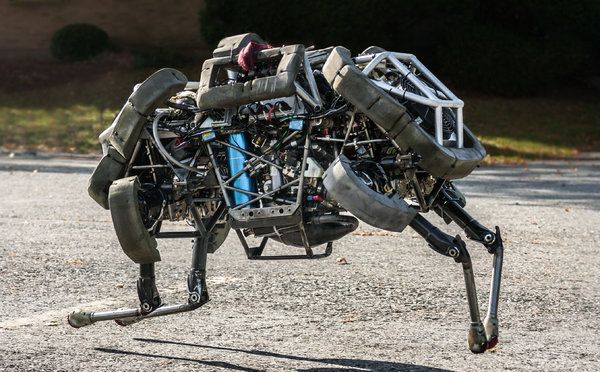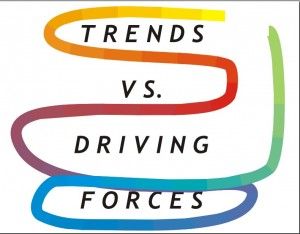Page 11921
Dec 15, 2013
China lands rover on moon’s surface, a first for the country
Posted by Seb in categories: space, space travel
Computerworld - China’s lunar probe, and the moon rover it carried, landed successfully Saturday night, marking a major accomplishment for the country’s space efforts.
This is the first time a spacecraft from China has landed on an extraterrestrial body. China becomes the third country, after the United States and Russia, to land a spacecraft on the moon.
China’s Chang’e-3 craft lifted off early on Dec. 2 on top of an enhanced Long March-3B rocket from the Xichang Satellite Launch Center in southwest China.
Dec 15, 2013
IFTTT can now automate actions based on your iPhone’s location
Posted by Seb in categories: automation, business, mobile phones

The clever automation service IFTTT is getting a lot more powerful today with the addition of location features. In an update to IFTTT’s iPhone app that’s rolling out now, the service will be able to begin watching your location, allowing it to automatically trigger tasks based on where you are. When you’re nearing home, you could have IFTTT automatically turn on your connected light bulbs, send an SMS to your roommate that you’re on the way, or send out a tweet that you’re back, among dozens of other possibilities. It’s also added in special triggers for Facebook, Twitter, Instagram, and Foursquare that can let you automate a task whenever you post from one of them at specific location.
Dec 15, 2013
Vegas developer selling $7.85M mansion for bitcoin
Posted by Seb in categories: bitcoin, business, economics
By Associated Press
The former owner of a Las Vegas casino says he’s willing to accept the online currency bitcoin in the $7.85 million sale of his home.
LAS VEGAS — A casino owner-turned-commercial developer is asking $7.85 million to sell a Las Vegas home, and he’s willing to accept the online currency bitcoin for the deal.
Continue reading “Vegas developer selling $7.85M mansion for bitcoin” »
Dec 14, 2013
A team of graduate students just 3D-printed a speaker and it works
Posted by Seb in category: 3D printing
Researchers at Cornell University have managed to 3D print a loudspeaker, according to the University’s newspaper. Using two customizable 3D printers originally developed at Cornell, a team of graduate mechanical engineering students managed to almost seamlessly print the loudspeaker’s plastic, cond
Dec 14, 2013
Meet the Robot Telemarketer Who Denies She’s A Robot
Posted by Seb in category: robotics/AI

By Zeke Miller and Denver Nicks — The phone call came from a charming woman with a bright, engaging voice to the cell phone of a TIME Washington Bureau Chief Michael Scherer. She wanted to offer a deal on health insurance, but something was fishy.
Several Time reporters called her back.
Continue reading “Meet the Robot Telemarketer Who Denies She’s A Robot” »
Dec 14, 2013
Google Adds to Its Menagerie of Robots
Posted by Seb in categories: business, defense, drones, engineering, futurism, government, human trajectories, law enforcement, military, robotics/AI
By JOHN MARKOFF

SAN FRANCISCO — BigDog, Cheetah, WildCat and Atlas have joined Google’s growing robot menagerie.
Google confirmed on Friday that it had completed the acquisition of Boston Dynamics, an engineering company that has designed mobile research robots for the Pentagon. The company, based in Waltham, Mass., has gained an international reputation for machines that walk with an uncanny sense of balance and even — cheetahlike — run faster than the fastest humans.
It is the eighth robotics company that Google has acquired in the last half-year. Executives at the Internet giant are circumspect about what exactly they plan to do with their robot collection. But Boston Dynamics and its animal kingdom-themed machines bring significant cachet to Google’s robotic efforts, which are being led by Andy Rubin, the Google executive who spearheaded the development of Android, the world’s most widely used smartphone software.
Dec 13, 2013
Superslide.
Posted by Andres Agostini in categories: business, complex systems, education, engineering, ethics, existential risks, finance, futurism, information science, philosophy, physics, science, singularity
Superslide. By Mr. Andres Agostini

This is an excerpt from the conclusion section of, “…Superslide (…A Three-Meter Slide).…” that discusses some management and futurism theories and practices. To read the entire piece, just click the link at the end of article:
EXCERPT. Ensuing:
“…Jeff Immelt realizes that the world changes every day and that his job is to keep GE competitive in that changing world. But his ability to take the company where it needs to go is greatly facilitated by the fact that he has a clear understanding of where he is starting…”
“…Stewart’s ranking reflects a massive movement underway to actually measure intellectual capital … The concept is correct and we put Stewart’s work right at the front … to reinforce the importance for companies to continue defining, measuring and improving ways of generating new intellectual capital … Teaching Organizations are the needed response to today’s emphasis on knowledge creation. Today, intellectual assets trump physical assets in nearly every industry.…”
Dec 13, 2013
Trends Vs. Dynamic Driving Forces.
Posted by Andres Agostini in categories: bitcoin, business, complex systems, education, energy, engineering, finance, futurism, information science, philosophy, physics, science, security, singularity, supercomputing
Trends Vs. Dynamic Driving Forces! By Mr. Andres Agostini
(Trends Vs. Dynamic Driving Forces, A Clarity-Driven Pathway Before A Universal Management and Scientific Blunder!).
This is an excerpt from the conclusion section of, “…Trends Vs. Dynamic Driving Forces…” that discusses some management and futurism theories and practices. To read the entire piece, just click the link at the end of article:
Dec 13, 2013
Superintelligence
Posted by Andres Agostini in categories: biological, biotech/medical, business, economics, education, energy, engineering, ethics, existential risks, exoskeleton, finance, futurism, health, life extension, philosophy, physics, policy, posthumanism, robotics/AI, science, singularity, supercomputing
Superintelligence! By Mr. Andres Agostini

This is an excerpt from the conclusion section of, “…Superintelligence…” that discusses some management theories and practices. To read the entire piece, just click the link at the end of article:

EXCERPT.
How do I exercise my mind? What types of thinking modes I daily use?
1. “Einsteinian Gedanke” Thinking
2. “Post Mortem” Thinking
3. “Pre Mortem” Thinking
4. “Short-Term and Long-Term” Thinking
5. “Terra Incognita” Thinking
6. “A Cappella” Thinking
7. “À la Quantum Mechanics” Thinking
8. “A Posteriori” Thinking
9. “A Priori” Thinking
10. “Against Fashionable” Thinking
11. “Against Inexpensive” Thinking
12. “Against Sloppy, Emotional” Thinking
13. “Against the whole cliche of the moment” Thinking
14. “Alpha and Omega” Thinking
15. “Applied Omniscience Knowledge” Thinking
16. “Continuous Improvement and Innovation” Thinking
17. “Edisonian Research” Thinking
18. “Over-Hauled Re-Engineering” Thinking
19. “Primum nocere” Thinking
20. “Primum non nocere” Thinking
21. “Rara Avis” Thinking
22. “Support Learning and Change” Thinking
23. A Radical yet Rigorous Strong-Sense and Critico-Creative
24. Aggregated Thinking
25. Alternatives-Exploring Thinking
26. Black-and-White Thinking
27. Bottom-Up Thinking
28. Cognitive Thinking
29. Composite Thinking
30. Compounded Thinking
31. Comprehensive Thinking
32. Cosmological Thinking
33. Counter-Cognitive Thinking
34. Counter-envisioning Thinking
35. Countering Thinking
36. Counter-intuitive Thinking
37. Counter-Intuitiveness Thinking
38. Countermeassuring Thinking
39. Counter-seeing Thinking
40. Cradle-to-grave Thinking
41. Cross-functional Thinking
42. Cross-pollinated Thinking
43. Cross-Referenced Thinking
44. Cybered Thinking
45. Cyber-Enabled Thinking
46. Deep Thinking
47. Dense Thinking
48. Discontinuous-Progression Thinking
49. Discoverer’s Thinking
50. Early-On Thinking
51. Easternized Thinking
52. Ecological Thinking
53. Engineering Thinking
54. Entomological Thinking
55. Epicentric Thinking
56. Epidemiological Thinking
57. Ex-ante Thinking
58. Exploratory Thinking
59. Exuberant Thinking
60. Factory Thinking
61. Forensic Thinking
62. Forethought Thinking
63. Forward Thinking
64. Futures Thinking
65. Futures Thinking
66. Fuzzy-Logic Thinking
67. Generative Thinking
68. Gestalt Thinking
69. Governed Thinking
70. GPS Thinking
71. Gray-areas Thinking
72. Harmonic Thinking
73. Helicopter Thinking
74. Heterodox Thinking
75. Heterodox Thinking
76. Hindsight Thinking
77. Holistic Thinking
78. Holistic Thinking
79. Horse-Seeing Thinking
80. Hyper-Geometrical Thinking
81. Illogicality Thinking
82. In-Advance Thinking
83. In-Parallel Thinking
84. In-Series Thinking
85. Inside-out Thinking
86. Integrative and Transformative Thinking
87. Interconnected Thinking
88. Interdependency Thinking
89. Interdisciplinary Thinking
90. Internetted Thinking
91. Interrelated Thinking
92. Inventor’s Thinking
93. Inward-Looking Thinking
94. Macro Thinking
95. Macroscopic Thinking
96. Metaphorical Thinking
97. Microscopic Thinking
98. Multidimensional Thinking
99. Multifaceted Thinking
100. Multilevel Thinking
101. Multi-Level Thinking
102. Multi-Perspective Thinking
103. Multi-Range Thinking
104. Multi-tasking Thinking
105. Mystified Thinking
106. Naturalist Thinking
107. Networked Thinking
108. Nonlinear Thinking
109. Non-Status Quo Thinking
110. Nuanced Thinking
111. Old-guard Thinking
112. Open Thinking
113. Orthodox Thinking
114. Outward-Looking Thinking
115. Parenthetic Thinking
116. Peripheral Thinking
117. Pluri-Filter Thinking
118. Pluri-Intent Thinking
119. Pre-“Post Mortem” Thinking
120. Preemptive Thinking
121. Pre-Forensic Thinking
122. Preter-Naturalist Thinking
123. Pseudo-Serendipitous Thinking
124. Qualitative Thinking
125. Quantitative Thinking
126. Radar Thinking
127. Radiant Thinking Irradiantly
128. Re-Engineering Thinking
129. Scenario-Method Thinking
130. Semi-Covert Thinking
131. Semigoverned Thinking
132. Semigoverned Thinking
133. Semipredictable Thinking
134. Semipredictable Thinking
135. Sonar Thinking
136. Sonar Thinking
137. Spacewalk Thinking
138. Spacewalk Thinking
139. Specificity Thinking
140. Specificity Thinking
141. Strategic Thinking
142. Strategic Thinking
143. Submarine Thinking
144. Submarine Thinking
145. Surprise-Free Thinking
146. Surprise-Free Thinking
147. Synergistic Thinking
148. Synergistic Thinking
149. Systems Thinking
150. Systems Thinking
151. Systemwide Thinking
152. Systemwide Thinking
153. Telescopic Thinking
154. Telescopic Thinking
155. Through-Paradoxes Thinking
156. Through-Paradoxes Thinking
157. Throughput Thinking
158. Throughput Thinking
159. Top-down Thinking
160. Top-down Thinking
161. Trans-Contextual Thinking
162. Trans-Contextual Thinking
163. Un-Commonsensical Thinking
164. Un-Commonsensical Thinking
165. Unconventional Thinking
166. Unconventional Thinking
167. Unconventionally-Uncommon Thinking
168. Unconventionally-Uncommon Thinking
169. Un-daydreamed-of Thinking
170. Un-Daydreamed-of Thinking
171. Undreamed-of Thinking
172. Undreamed-of Thinking
173. Unorthodox Thinking
174. Unthinkable Thinking
175. Upside-down Thinking
176. Vanguard Thinking
177. Vertical-lateral-+Thinking
178. Weird Science’s Thinking
179. Weirdo’s Thinking
180. Westernized Thinking
181. Wholeness Thinking
182. Womb-to-tomb Thinking











